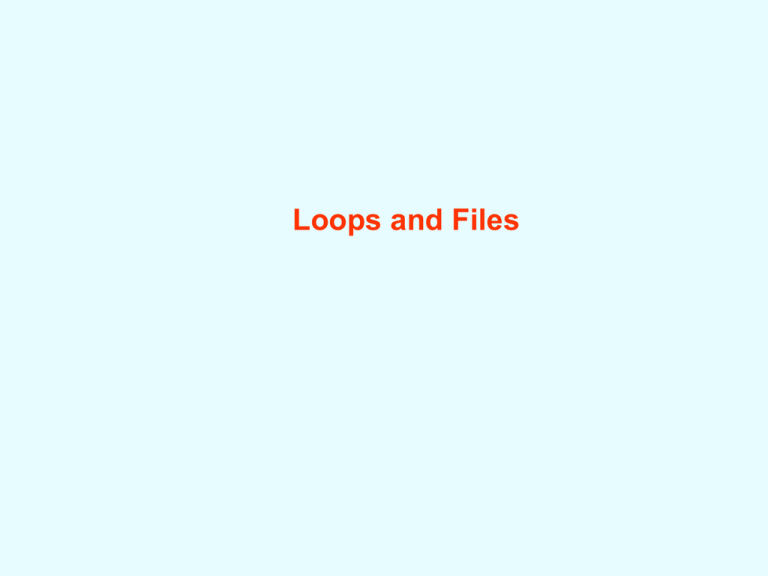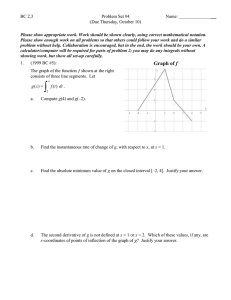Loops and Files
advertisement

Loops and Files
5.1
The Increment and Decrement
Operators
The Increment and Decrement
Operators
• ++ is the increment operator.
It adds one to a variable.
val++; is the same as val = val + 1;
• ++ can be used before (prefix) or after (postfix) a
variable:
++val;
val++;
The Increment and Decrement
Operators
• -- is the decrement operator.
It subtracts one from a variable.
val--; is the same as val = val - 1;
• -- can be also used before (prefix) or after
(postfix) a variable:
--val;
val--;
Increment and Decrement
Operators in Program 5-1
Continued…
Increment and Decrement
Operators in Program 5-1
Prefix vs. Postfix
• ++ and -- operators can be used in
complex statements and expressions
• In prefix mode (++val, --val) the
operator increments or decrements, then
returns the value of the variable
• In postfix mode (val++, val--) the
operator returns the value of the variable,
then increments or decrements
Prefix vs. Postfix - Examples
int num, val = 12;
cout << val++; // displays 12,
// val is now 13;
cout << ++val; // sets val to 14,
// then displays it
num = --val;
// sets val to 13,
// stores 13 in num
num = val--;
// stores 13 in num,
// sets val to 12
Notes on Increment and
Decrement
• Can be used in expressions:
result = num1++ + --num2;
• Must be applied to something that has a location
in memory. Cannot have:
result = (num1 + num2)++;
• Can be used in relational expressions:
if (++num > limit)
pre- and post-operations will cause different
comparisons
5.2
Introduction to Loops: The while
Loop
Introduction to Loops:
The while Loop
• Loop: a control structure that causes a
statement or statements to repeat
• General format of the while loop:
while (expression)
statement;
• statement; can also be a block of
statements enclosed in { }
The while Loop – How It Works
while (expression)
statement;
• expression is evaluated
– if true, then statement is executed, and
expression is evaluated again
– if false, then the loop is finished and
program statements following statement
execute
The Logic of a while Loop
The while loop in Program 5-3
How the while Loop in Program 53 Lines 9 through 13 Works
Flowchart of the while Loop in
Program 5-3
The while Loop is a Pretest Loop
expression is evaluated before the
loop executes. The following loop will
never execute:
int number = 6;
while (number <= 5)
{
cout << "Hello\n";
number++;
}
Watch Out for Infinite Loops
• The loop must contain code to make
expression become false
• Otherwise, the loop will have no way of
stopping
• Such a loop is called an infinite loop,
because it will repeat an infinite number of
times
Example of an Infinite Loop
int number = 1;
while (number <= 5)
{
cout << "Hello\n";
}
5.3
Using the while Loop for Input
Validation
Using the while Loop for
Input Validation
• Input validation is the process of
inspecting data that is given to the
program as input and determining whether
it is valid.
• The while loop can be used to create input
routines that reject invalid data, and repeat
until valid data is entered.
Using the while Loop for
Input Validation
• Here's the general approach, in
pseudocode:
Read an item of input.
While the input is invalid
Display an error message.
Read the input again.
End While
Input Validation Example
cout << "Enter a number less than 10: ";
cin >> number;
while (number >= 10)
{
cout << "Invalid Entry!"
<< "Enter a number less than 10: ";
cin >> number;
}
Flowchart for Input Validation
Input Validation in Program 5-5
5.4
Counters
Counters
• Counter: a variable that is incremented or
decremented each time a loop repeats
• Can be used to control execution of the
loop (also known as the loop control
variable)
• Must be initialized before entering loop
A Counter Variable Controls the
Loop in Program 5-6
Continued…
A Counter Variable Controls the
Loop in Program 5-6
5.5
The do-while Loop
The do-while Loop
• do-while: a posttest loop – execute the loop,
then test the expression
• General Format:
do
statement; // or block in { }
while (expression);
• Note that a semicolon is required after
(expression)
The Logic of a do-while Loop
An Example do-while Loop
int x = 1;
do
{
cout << x << endl;
} while(x < 0);
Although the test expression is false, this loop will
execute one time because do-while is a posttest
loop.
A do-while Loop in Program 5-7
Continued…
A do-while Loop in Program 5-7
do-while Loop Notes
• Loop always executes at least once
• Execution continues as long as
expression is true, stops repetition
when expression becomes false
• Useful in menu-driven programs to bring
user back to menu to make another choice
(see Program 5-8 on pages 245-246)
5.6
The for Loop
The for Loop
• Useful for counter-controlled loop
• General Format:
for(initialization; test; update)
statement; // or block in { }
• No semicolon after the update expression or
after the )
for Loop - Mechanics
for(initialization; test; update)
statement; // or block in { }
1) Perform initialization
2) Evaluate test expression
–
–
If true, execute statement
If false, terminate loop execution
3) Execute update, then re-evaluate test
expression
for Loop - Example
int count;
for (count = 1; count <= 5; count++)
cout << "Hello" << endl;
A Closer Look
at the Previous Example
Flowchart for the Previous Example
A for Loop in Program 5-9
Continued…
A for Loop in Program 5-9
A Closer Look at Lines 15 through
16 in Program 5-9
Flowchart for Lines 15 through 16
in Program 5-9
When to Use the for Loop
• In any situation that clearly requires
– an initialization
– a false condition to stop the loop
– an update to occur at the end of each iteration
The for Loop is a Pretest Loop
• The for loop tests its test expression
before each iteration, so it is a pretest
loop.
• The following loop will never iterate:
for (count = 11; count <= 10; count++)
cout << "Hello" << endl;
for Loop - Modifications
• You can have multiple statements in the
initialization expression. Separate
the statements with a comma:
Initialization Expression
int x, y;
for (x=1, y=1; x <= 5; x++)
{
cout << x << " plus " << y
<< " equals " << (x+y)
<< endl;
}
for Loop - Modifications
• You can also have multiple statements in
the test expression. Separate the
statements with a comma:
Test Expression
int x, y;
for (x=1, y=1; x <= 5; x++, y++)
{
cout << x << " plus " << y
<< " equals " << (x+y)
<< endl;
}
for Loop - Modifications
• You can omit the initialization
expression if it has already been done:
int sum = 0, num = 1;
for (; num <= 10; num++)
sum += num;
for Loop - Modifications
• You can declare variables in the
initialization expression:
int sum = 0;
for (int num = 0; num <= 10;
num++)
sum += num;
The scope of the variable num is the for loop.
5.7
Keeping a Running Total
Keeping a Running Total
• running total: accumulated sum of numbers from
each repetition of loop
• accumulator: variable that holds running total
int sum=0, num=1; // sum is the
while (num <= 10) // accumulator
{ sum += num;
num++;
}
cout << "Sum of numbers 1 – 10 is"
<< sum << endl;
Logic for Keeping a Running Total
A Running Total in Program 5-12
Continued…
A Running Total in Program 5-12
5.8
Sentinels
Sentinels
• sentinel: value in a list of values that
indicates end of data
• Special value that cannot be confused with
a valid value, e.g., -999 for a test score
• Used to terminate input when user may
not know how many values will be entered
A Sentinel in Program 5-13
Continued…
A Sentinel in Program 5-13
5.9
Deciding Which Loop to Use
Deciding Which Loop to Use
• The while loop is a conditional pretest loop
– Iterates as long as a certain condition exits
– Validating input
– Reading lists of data terminated by a sentinel
• The do-while loop is a conditional posttest loop
– Always iterates at least once
– Repeating a menu
• The for loop is a pretest loop
– Built-in expressions for initializing, testing, and updating
– Situations where the exact number of iterations is known
5.10
Nested Loops
Nested Loops
• A nested loop is a loop inside the body of
another loop
• Inner (inside), outer (outside) loops:
for (row=1; row<=3; row++) //outer
for (col=1; col<=3; col++)//inner
cout << row * col << endl;
Nested for Loop in Program 5-14
Inner Loop
Outer Loop
Nested Loops - Notes
• Inner loop goes through all repetitions for
each repetition of outer loop
• Inner loop repetitions complete sooner
than outer loop
• Total number of repetitions for inner loop
is product of number of repetitions of the
two loops.




